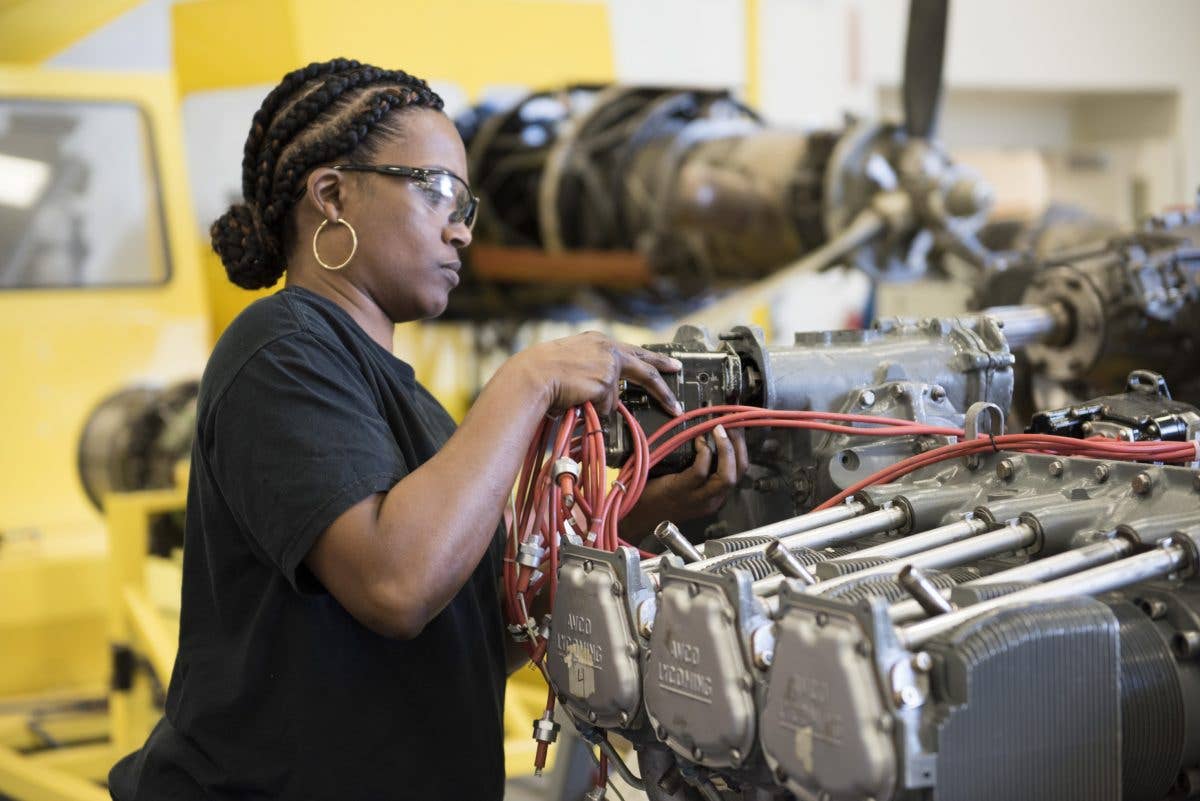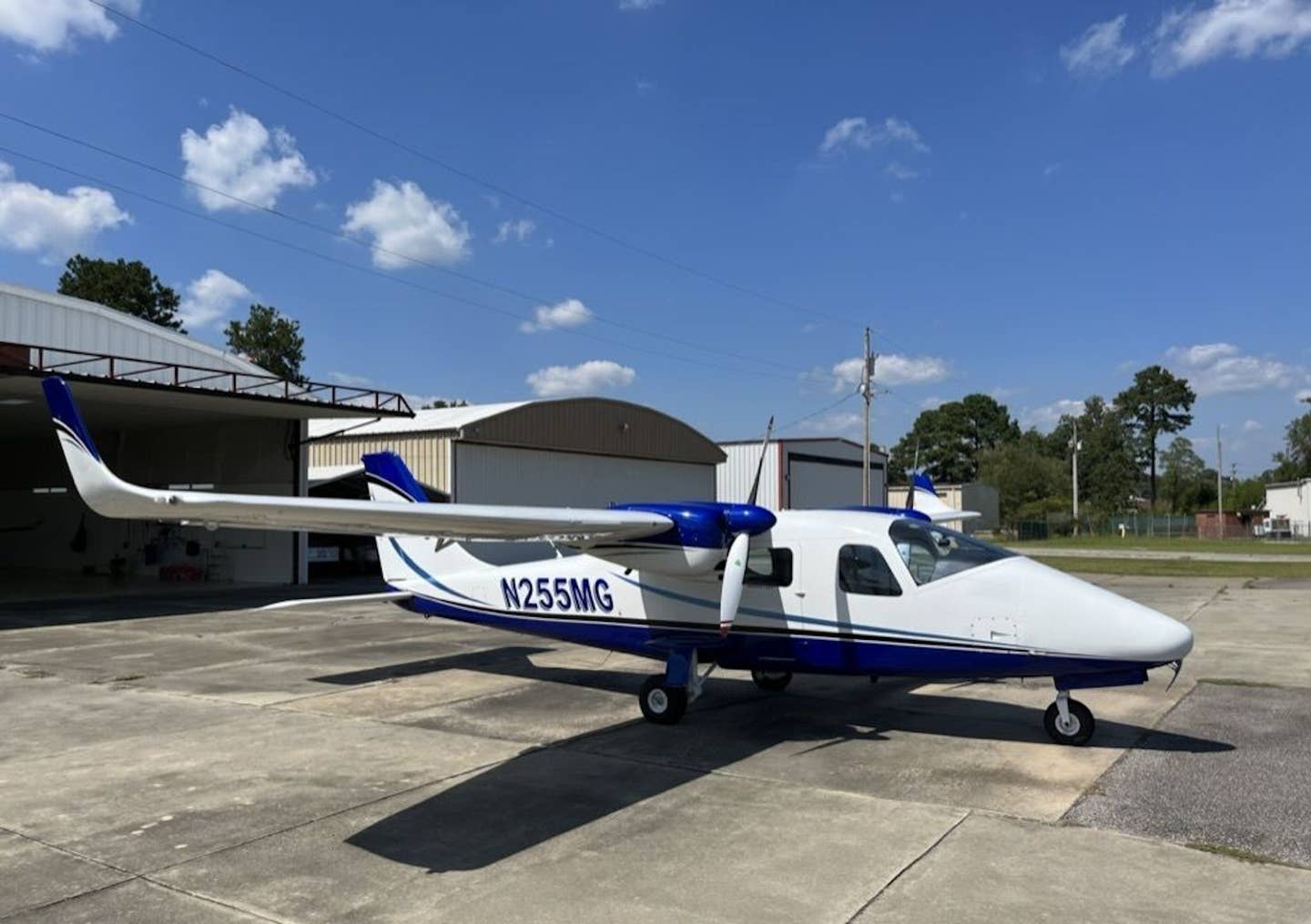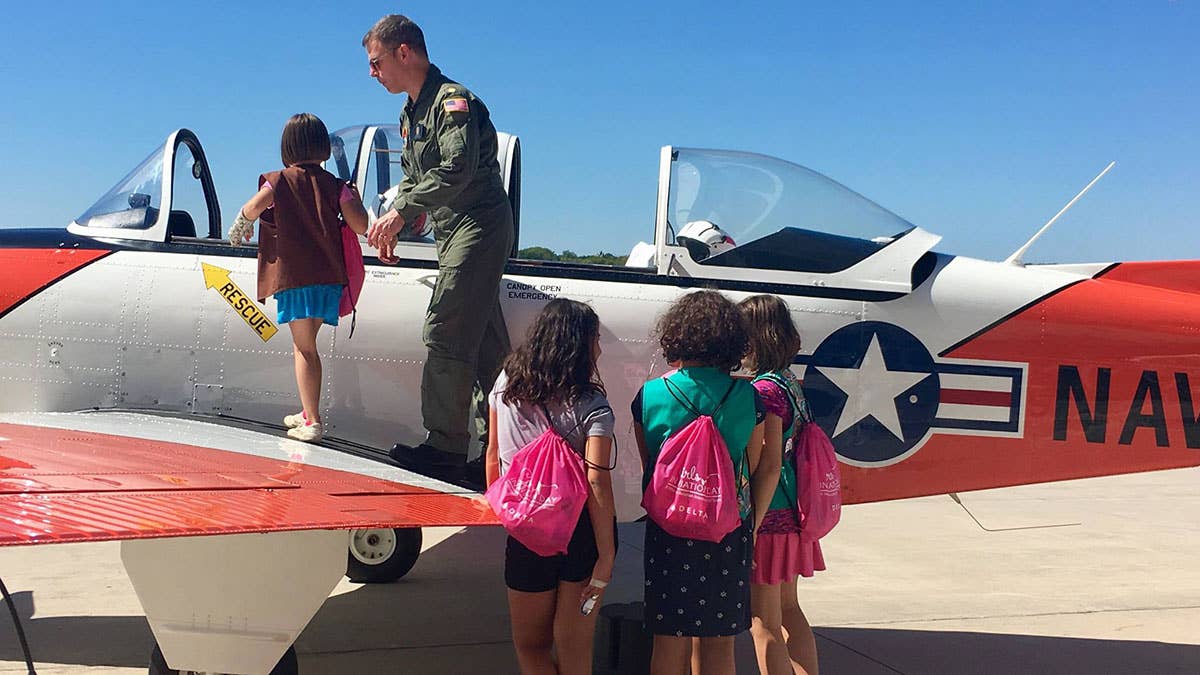What Does It Take to Become an A&P?
There are multiple pathways to what can be a challenging and rewarding career.

Getting your A&P just might be more accessible than you think. [Credit: Abbye Garcia for Rock Valley College]
Editor’s Note: This story originally appeared on Plane & Pilot.
Have you ever thought about getting your A&P? Maybe you want to learn more about aircraft systems to become a better pilot. Perhaps you would like to save money doing maintenance on your own aircraft. Or maybe you’re looking for a career change or retirement job. Whatever the motivation, many pilots have considered getting their mechanic’s certificate but don’t know what is involved or how to begin. Getting your A&P just might be more accessible than you think.
Why Get Your A&P?
Obtaining your mechanic certificate, more commonly known as an A&P, for the airframe and powerplant ratings on it, offers many advantages. As pilots, we all need to understand how the systems on our aircraft operate. Beginning with initial flight training, we need to understand how the aircraft, engine, electrical, and other systems function—or malfunction—to ensure a safe outcome in any situation. Having a deeper understanding of aircraft systems can help you make better preflight or en route decisions or simply help you to operate your aircraft more efficiently and take better care of it.
For aircraft owners, the biggest attraction is the cost savings from doing your own maintenance. Even if it’s something you can’t do yourself, you’ll be better informed to evaluate and make decisions about the work your mechanic recommends. In addition to doing your own maintenance, having your mechanic certificate can create the opportunity for some extra income, working part time as aside gig or retirement job.
If you are interested in a career change, there’s never been a better time to find work in aviation maintenance. While the pilot shortage has been widely publicized, alls ectors of aviation are desperate to fill mechanic slots as well. General aviation shops are especially shorthanded, causing lengthy delays in scheduling annual inspections, engine overhauls and other maintenance for aircraft owners.
Requirements
The requirements for obtaining an aircraft mechanic certificate are outlined in 14 CFR Part 65 Subpart D. You must be at least 18 years old; read, write, speak and understand English; and complete the required testing. No medical is required. Like pilot certificates, a mechanic certificate is issued with no expiration date. To maintain currency, you must work as a mechanic or in a supervisory capacity for six months out of the preceding 24 months.
As with pilot ratings, the experience, knowledge and skill requirements are outlined in the FARs and the newly-revised Airmen Certification Standards (ACS), which replaced the existing mechanic practical test standards on September 21, 2022. Applicants must demonstrate experience and knowledge in a range of subjects under three categories: general, airframe and powerplant. The general portion includes topics such as basic math and physics, materials, basic electricity, an understanding of the FARs, and safety. Airframe topics include fuel systems, assembly and rigging, landing gear, sheet metal, and more. Powerplant subjects cover everything engine-related, including piston and turbine powerplant operation, ignition systems, fuel and lubrication, and propellers.
After acquiring the required knowledge and experience, applicants must pass a knowledge (computer-based) test with at least 70 percent for each category. After passing the knowledge test, the applicant will schedule their “check ride,” that is, the oral and practical test (O&P) with a designated mechanic examiner (DME). You must pass the oral and practical tests within 24 months after taking the knowledge test.
The mechanic certificate cannot be issued for general alone; it must be combined with either an airframe or powerplant rating for initial certification. After that, you can complete a separate knowledge and O&P test for the other rating. While getting both airframe and powerplant ratings is not required, as a practical matter, most people do obtain both to give them the knowledge and privileges to work on the entire aircraft.
Privileges and Limitations
Like your pilot certificate, a mechanic certificate is a license to learn. The FAA has designed the requirements to ensure a broad foundation in aviation maintenance. With your ticket in your pocket, it is up to you (or your employer) to seek out information and training specific to the aircraft or equipment you will be working on.
The privileges and limitations of a mechanic certificate are outlined in 14 CFR part 65. Mechanics can perform maintenance, minor repairs, minor alterations and 100-hour inspections as permitted by their rating—airframe and/or powerplant. A&Ps may not work on certain equipment, such as propellers and avionics, which must be serviced at an appropriately certified repair station. Major repairs, major alterations and annual inspections must be performed by a mechanic holding an Inspection Authorization rating (IA).This is an additional rating that can be added after three years’ experience as a mechanic and passing an additional knowledge test.
Knowledge
To become an A&P—also called an AMT, or aircraft maintenance technician—you will need to build a foundation of maintenance knowledge. The Part 147 Airmen Certification Standards detail the specific items you must know and understand. The FAA publishes general, airframe, and powerplant handbooks covering all the required material, and they are available for free in PDF format on the FAA website or can be purchased in paperback from various retailers. Test prep programs and apps are available to help you study for the written and oral tests.
Experience
Part 65.77 states that prior to taking the knowledge tests, applicants must have “at least 18 months of practical experience with the procedures, practices, materials, tools, machine tools, and equipment generally used in constructing, maintaining, or altering airframes, or powerplants appropriate to the rating sought” or a minimum of 30 months’ practical experience for both airframe and powerplant. This experience is typically interpreted as the equivalent of working full-time hours for the given period of time.
Two pathways exist for gaining the knowledge and experience you need to become an A&P: attending a Part 147 AMT school or on-the-job training (OJT) through civilian or military experience. The path that works best for you depends on your individual situation. If you have already served in the military in certain aircraft maintenance roles, you can use your time in the service toward the experience requirements. You will need to present specific documentation of your time to the local Flight Standards District Office (FSDO) for review. Additional information about what is required can be found on the FAA website Experience Requirements page.
The on-the-job route appeals to many people because it can be the most cost-effective way to gain necessary experience because you are getting paid while working in a maintenance facility. The rates for apprentices or mechanic’s assistants are at a lower, entry level of pay than for certified mechanics. However, you have the opportunity to gain valuable industry experience and connections, which are especially helpful if you plan to seek future employment in the field. OJT can be part of a formally structured program at a large repair station or employment working at your local FBO. In some cases, if you are rebuilding or restoring your own airplane under the supervision of an A&P, you can log that time, too.
Whatever your situation is, you are responsible for carefully tracking the hours worked and type of work you do. The FAA does not specify a particular format for documenting your time. You can use an electronic spreadsheet or written log. Maintenance logbooks, just like pilot logbooks, are available from aviation shops and online retailers. Whatever format you choose, you must include the following information: type of maintenance task performed, amount of time spent on each task, and validation by a certificated Airframe and/or Powerplant Technician. Just like the military pathway, when you have completed your experience, you will need to present your documented time to the FSDO for review to receive a signoff to take the knowledge test. The on-the-job training route provides interesting, real-word experience, as you never know what type of work might roll into the hangar.
However, depending on the type of shop you work at and the position you hold, you may get to see a wide range of maintenance issues that meet many of the FAA requirements, or your work may be focused on a narrower range of jobs on specialized systems or equipment. Whatever the case, it is up to you to seek experience with the range of tasks the FAA expects. Similarly, it is up to you to gain the knowledge required through self-study, test prep books and apps, online courses or other instructional tools and prepare for the written, oral and practical tests.
Because it can be a challenge to piece together the necessary experience in a working shop, many people choose the school route. Aviation Maintenance Technician Schools (AMTS) are technical programs that operate under the requirements of Part 147 and design their instructional programs to meet the requirements of the Part 147 ACS. AMTS may be run by for-profit companies, public and private universities, community colleges or other technical schools.
The big advantage of the school setting is that the curriculum is designed to cover the range of FAA-required subjects and tasks in a structured, organized manner. The maintenance ACS dictates the specific knowledge, skills and risk management elements required to pass the knowledge test and O&Ps. Part 147 AMTS programs typically take around two years of full-time attendance to complete, but the actual schedule varies by school. These programs prepare you for the knowledge, oral, and practical tests.
Students who successfully complete the program receive certificates of completion that authorize them to take the knowledge tests. College and university programs also provide opportunities to earn associate’s or bachelor’s degrees by completing additional general education requirements.
When selecting a school, be sure that it is an FAA Part 147-approved program. The FAA website has a search engine that allows you to search for AMTS by state. Because all schools must meet Part 147 requirements, you will learn the same content wherever you go. Factors such as location, cost, schedule and school facilities vary, so you should research and visit the programs that interest you and choose the one that best fits your needs.
Tuition can range widely from $17,000 to $40,000 or more for a two-year program depending on the type of institution. Additional costs include tools, books, lab or materials fees, and testing fees.
Keeping Costs Down
While the costs of attending an AMTS may leave you with sticker shock at first glance, if you know where to look, you can find many ways to defray the expense. By choosing your program carefully, you can cut the overall tuition expense before you even start. All Part 147 AMTS teach the same FAA-required content and prepare you to get your mechanic certificate. Community colleges are usually the most cost-effective, as they have lower per-hour tuition rates than other types of schools, especially for in-district students. Because only a few AMTs operate in each state, you may live in an area served by a community college without a maintenance program. If this is the case, the community college in your district may have a charge-back or joint agreement with a nearby school that has an AMTS, allowing you to attend that school at in-district rates.
Retirees can do even better. In many states, senior citizens can enroll in and attend credit courses at community colleges tuition-free on a space-available basis (additional college, lab or testing fees are not covered). Restrictions vary widely and may limit which programs are eligible for this discount, either by policy or due to high demand and lack of available slots in the program. However, if the program rules and space allow, it is possible to earn your A&P for drastically reduced costs.
Discounted tuition may be available to veterans and active members of the military. Veterans can contact the individual school for information about using their GI bill benefits to pay for tuition. Financial aid, loans and grants are available at most institutions for military personnel, veterans and civilians.
Perhaps one of the best-kept secrets is the number of scholarships available—and you don’t have to be a perfect student or a young person to be eligible. If you’re willing to put in a little time to search for them and apply, there’s money to be found. National organizations such as the Association of Women in Aviation Maintenance (AWAM) and National Business Aircraft Association (NBAA) and numerous maintenance and manufacturing companies offer scholarships every year. Check out the organizations’ websites to learn more.
Sometimes the best place to find scholarships is close to home. While the local organizations may offer smaller dollar amounts, every little bit helps. Most colleges have lists of scholarships available to their students set up by alumni or other donors. Scholarship money frequently goes unclaimed because of lack of qualified, or even any, applicants. Look to your local airport or groups in which you are already involved. Local chapters of national organizations, aviation clubs and museums may offer scholarships—and if you are already involved in these groups, you’re more likely to be considered.
Getting Started
So, you’ve decided to get your A&P? Where do you begin? For an overview of requirements and answers to frequently asked questions about becoming a mechanic, visit the FAA website.
Next, talk to mechanics and pilots you know. Networking is a great way to learn more about the opportunities out there and anyone who can help guide you. Your own local mechanic may be looking for help in the shop or know someone who is. Plus, they will be able to give you some insight on the industry and day-to-day work.
If you are interested in going to an AMTS, start by searching for Part 147 schools in your area. Then, check the school website and contact the program administrator for information about the program requirements, costs and enrollment.
Ready to start learning? Check out the Part 147 ACS to learn more about the specific knowledge and skills you need. You can start reading up on them in the Aviation Maintenance Technician General, Airframe (Vol. 1 & 2) and Powerplant (Vol. 1 & 2) handbooks.
Editor’s Note: This story originally appeared in the NOV/DEC 2022 issue of Plane & Pilot magazine.

Subscribe to Our Newsletter
Get the latest FLYING stories delivered directly to your inbox






